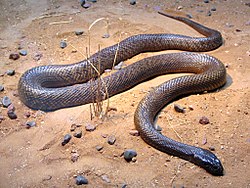Inland taipan
| Fierce Snake (Inland Taipan) | |
|---|---|

| |
| Scientific classification | |
| Kingdom: | |
| Phylum: | |
| Class: | |
| Order: | |
| Suborder: | |
| Family: | |
| Genus: | |
| Species: | O. microlepidotus
|
| Binomial name | |
| Oxyuranus microlepidotus (McCoy, 1879)
| |

| |
| Range of Inland Taipan (in red) | |
The Inland Taipan (Oxyuranus microlepidotus), also known as the Small Scaled Snake and Fierce Snake, is native to Australia and is the most venomous land snake on Earth to mice.[1][2] It is a species of taipan belonging to the Elapidae family. Although highly venomous, it is very shy and reclusive, and prefers to escape from trouble, biting only if threatened.[3]
Venom
The Inland Taipan's venom consists of Taipoxin and protease enzymes, each bite injecting as much as 110 mg (44 mg on average) of venom. The median lethal dose (LD50) for mice is 2 μg/kg (ppb) for pure Taipoxin[4] and 30 μg/kg (ppb) for the natural venom mixture.[5] Its venom is 200 to 400 times as toxic as that of most rattlesnakes, and fifty times as toxic as that of a cobra. Its venom is a neurotoxin that could potentially kill an adult human in forty-five minutes.[citation needed] All reported bite victims have been treated with antivenom, and there have been no documented fatalities.[citation needed] As of late 2003, all positively identified inland taipan bite victims have been herpetologists handling the snakes for study,[6] although there have been many unverified reports of bites likely caused by the species.[7]
Appearance


The Inland Taipan is dark tan, ranging from a rich, dark hue to a brownish olive-green, depending on season. Its back, sides and tail may be different shades of brown and grey, with many scales having a wide blackish edge. These dark-marked scales occur in diagonal rows so that the marks align to form broken chevrons of variable length that are inclined backward and downward. The lowermost lateral scales often have an anterior yellow edge. The dorsal scales are smooth and without keels. The round-snouted head and neck are usually noticeably darker than the body (glossy black in winter, dark brown in summer), the darker colour allowing the snake to heat itself while only exposing a smaller portion of the body at the burrow entrance. The eye is of average size with a blackish brown iris and without a noticeable coloured rim around the pupil. It has twenty-three rows of mid-body scales, between fifty-five and seventy divided subcaudal scales, and one anal scale. The Inland Taipan averages approximately 1.8 metres (5.9 ft) in length, although larger specimens can reach lengths of 2.5 metres (8.2 ft).[8]
Seasonal adaptation
Inland taipans adapt to their environment by changing the colour of the skin during seasonal changes. They tend to become lighter during summer and darker during the winter. This seasonal color change serves the purpose of thermoregulation, allowing the snake to absorb more light in the colder months.
Geographical distribution
The inland taipan is native to the arid regions of central Australia. Its range extends from the southeast part of the Northern Territory into west Queensland. The snake can also be found north of Lake Eyre and to the west of the split of the Murray River, Darling River, and Murrumbidgee River.
Behavior
The Inland Taipan lives in holes and feed on small rodents such as mice and rats.
Diet
The Inland Taipan consumes mostly rodents, small mammals and birds. It kills with a single accurate bite, then retreats while waiting for the prey to die before returning to safely consume its meal.
Reproduction
Inland Taipan produce clutches of between one and two dozen eggs. The eggs hatch two months after. The eggs are usually laid in abandoned animal burrows and deep crevices. Reproduction rate depends in part on their diet. If there is not enough food then the snake will reproduce less.
References
Notes
- ^ LD50 Values for snake venom, 1999
- ^ www.manbir-online.com
- ^ "Our Animals - Reptiles - Venomous Snakes - Fierce Snake". Australia Zoo. Retrieved 2009-05-21.
- ^ J. Fohlman, D. Eaker, E. Karlsoon, S. Thesleff: "Taipoxin, an extremely potent presynaptic neurotoxin from the venom of the australian snake taipan (Oxyuranus s. scutellatus). Isolation, characterization, quaternary structure and pharmacological properties." Eur. J. Biochem. 1976 Sep 15;68(2):457-69.
- ^ "Strength of Venom". School of Chemistry, University of Bristol. Retrieved 2008-02-29.
- ^ Barrett, Robyn (2003). "Five years of snake envenoming in far north Queensland". Emergency Medicine. 15 (5–6): 500–510. doi:10.1046/j.1442-2026.2003.00509.x. PMID 14992068.
There have only been a handful of reports of envenoming by the inland taipan (Oxyuranus microlepidotus). As in our patient, they have only occurred in herpetologists.
{{cite journal}}:|access-date=requires|url=(help); Unknown parameter|coauthors=ignored (|author=suggested) (help); Unknown parameter|month=ignored (help) - ^ White, Julian (November 1991). "Oxyuranus microlepidotus". Chemical Safety Information from Intergovernmental Organizations. Retrieved 24 July 2009.
- ^ "Fierce Snake (Inland Taipan)". Australian Reptile Park. Retrieved 2009-11-07.

